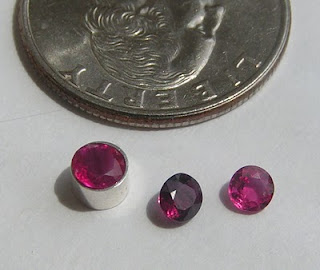Dime a Dozen or Hard to Find?
It really took me a while to get the hang of determining which gemstones are rare and which aren’t. This shouldn’t have been so hard, but because markups in colored stones are often high, it really isn’t in the jewelry industry’s best interest to make that information easy to obtain. And gemstone dealers always want to tell you that their offerings are rare.
So I’ve tried to come up with my own scale of rarity. First, however, there’s a misconception we need to get out of the way:
If a gemstone is expensive, it must be rare. This isn’t true.
Yes, some gemstones are expensive because they are rare, but this doesn’t generalize, and for two reasons. Some gemstones are marked up because everybody knows about them, and they are popular. The gems that the industry qualifies as “precious” (this is an artificial distinction) fall into this category: diamond, ruby, emerald, sapphire, probably in that order. Diamonds are more abundant than almost any other gemstone, but they are popular and the inventory is controlled by just a few companies. Sapphires are fairly common as well.
Secondly, some gems that are so rare that they cannot be mass marketed at all. These stones barely penetrate the jewelry industry, which means that demand for these stones is limited. That, in turn, keeps the price lower. Tsavorite, Spessartite and Spinel are great examples.
Ok, so here’s the Raley Scala of Rarity. Due to my still limited experience, not every stone is on here. Also, this list is the outcome of to my personal experience of finding gemstones. I very much doubt it is an adequate reflection of available gemstone deposits. That info is much harder to come by, and gemstone dealers and mine owners are very secretive about it. For another list, by the way (one which I used to crosscheck my data), you can consult Matlins’ and Bonnano’s “Jewelry & Gems: The Buying Guide.”
Next to each stone I will also indicate some relative pricing. Here are the letters I’ll use.
D: Dirt cheap
I: Inexpensive
M: Moderate
E: Expensive
P: Prohibitive
Common
Feldspar (moonstone and labradorite, sunstone) – D
Garnet (red) - D
Peridot, small sizes – I (but not D)
Quartz (Amethyst, Citrine, Rose Quartz, Crystal
Topaz (any except for Imperial Topaz) – D
Generally Available
Aquamarine – I to M
Emerald from Brazil
Iolite - I
Sapphire (blues, orange and yellow but not Burma or Ceylon
Tourmaline – I for the grassier greens, M for some of the indicolites and chrome green
Harder to Find
Apatite (maybe because it is hard to cut) – I to M
Ruby (not Burma
Spessartite Garnet – M
Zircon – I to M depending on color, the blue is more expensive, unheated is more expensive
 |
| Spessartite Garnet |
Rare
Alexandrite (Russian is very rare, Indian and Sri Lankan less so) – E to P
Columbian Emerald, untreated – E
Crysoberyl – I to M
Mandarin Garnet (very orangy spessartite, larger sizes) - E
Spinel – (blue and pink more common, M, reds are rare and E)
Tsavorite Garnet – M for small sizes, E-P for larger sizes
 |
| Untreated Columbian Emeralds, Various Sizes |
Very Rare
Padparadscha Sapphire - P
Untreated Burma
 |
| Untreated Burma Rubies |
A problem stone for me is Tanzanite. Unheated ones are barely on the market, heated ones are fairly common except larger sizes. Some say Tanzanite is getting mined out, others say that this is a marketing trick. In any case, Tanzanite is now often qualified as precious, and thus expensive.
Another stone I left out because I don’t know enough about it is opal. Fire opals, which come out of Mexico
